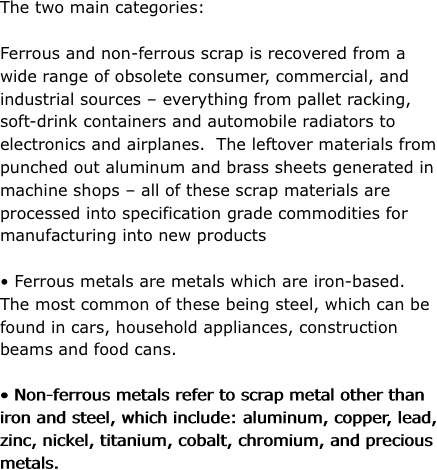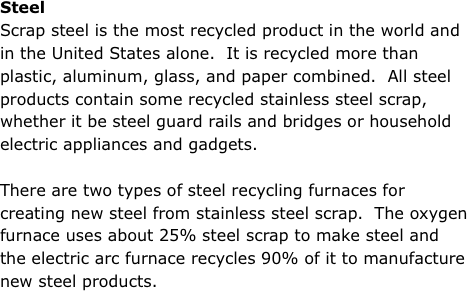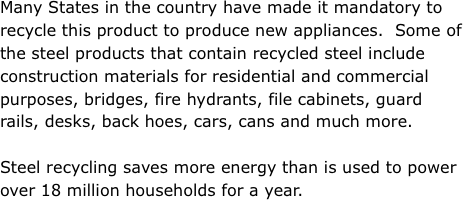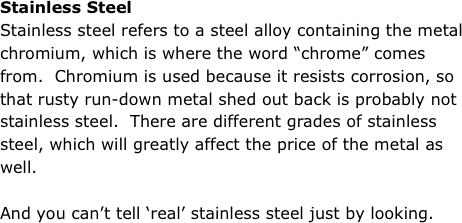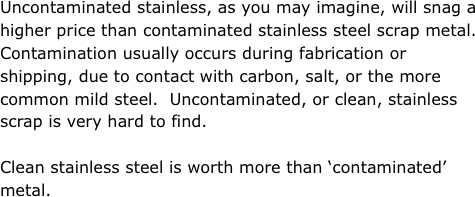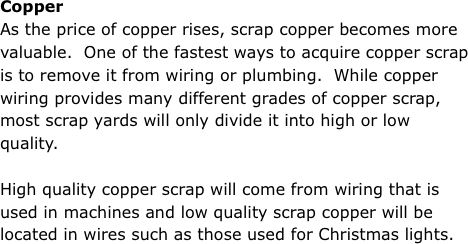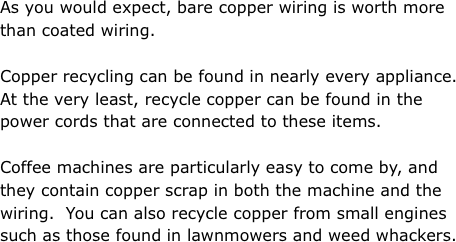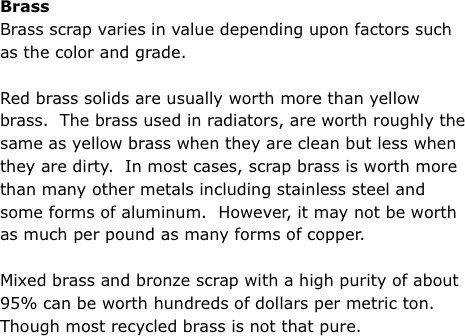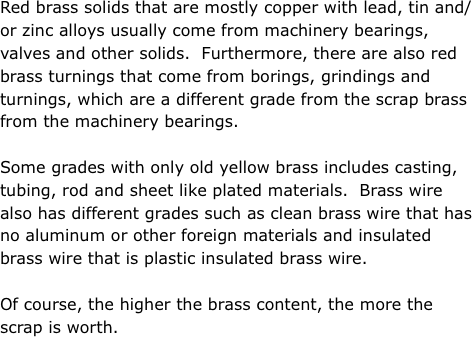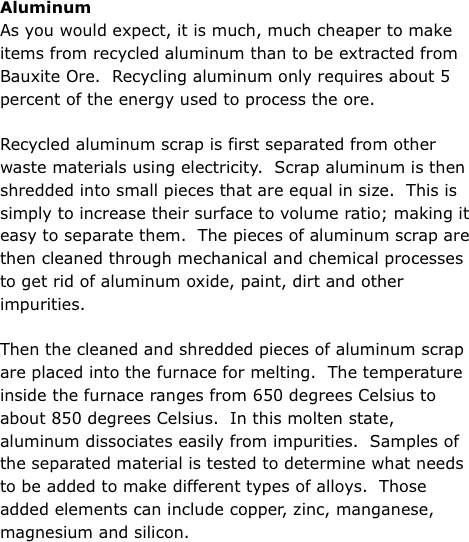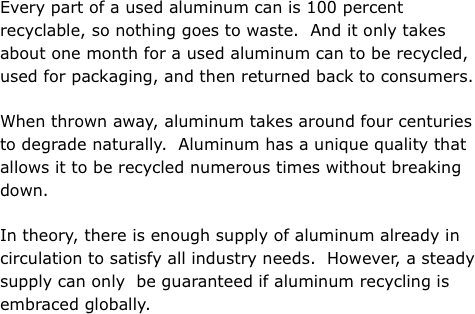








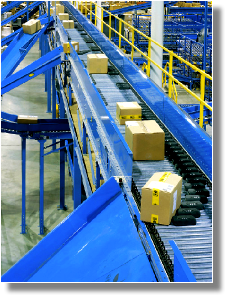

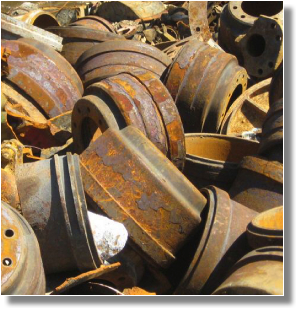
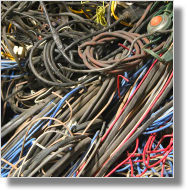



![]()
First of all, no matter what type of scrap metal you have, it is always more valuable in volume and when sorted properly.
The two main categories:
Ferrous and non-ferrous scrap is recovered from a wide range of obsolete consumer, commercial, and industrial sources – everything from soft-drink containers to automobile radiators to electronics and airplanes. The leftover materials from punched out aluminum and brass sheets generated in machine shops – all of these scrap materials are processed into specification grade commodities for manufacturing into new products
• Ferrous metals are metals which are iron-based. The most common of these being steel, which can be found in cars, household appliances, construction beams and food cans.
• Non-ferrous metals refer to scrap metal other than iron and steel, which include: aluminum, copper, lead, zinc, nickel, titanium, cobalt, chromium, and precious metals.
Magnet Test! To find out if your metals are ferrous or non-ferrous, simply grab a magnet and see if it will stick to the item. If it sticks, it is ferrous. If it doesn’t stick, it is non-ferrous.
A short overview of the most commonly recycled metals.
Scrap Steel
Scrap steel is the most recycled product in the world and in the United States alone. It is recycled more than plastic, aluminum, glass, and paper combined. All steel products contain some recycled stainless steel scrap, whether it be steel guard rails and bridges or household electric appliances and gadgets. There are two types of steel recycling furnaces for creating new steel from stainless steel scrap. The oxygen furnace uses about 25% steel scrap to make steel and the electric arc furnace recycles 90% of it to manufacture new steel products. Many States in the country have made it mandatory to recycle this product to produce new appliances. Some of the steel products that contain recycled steel include construction materials for residential and commercial purposes, bridges, fire hydrants, file cabinets, guard rails, desks, back hoes, cars, cans and much more. Steel recycling saves more energy than is used to power over 18 million households for a year.
Scrap Stainless Steel
Stainless steel refers to a steel alloy containing the metal chromium, which is where the word “chrome” comes from. Chromium is used because it resists corrosion, so that rusty run-down metal shed out back is probably not stainless steel. There are different grades of stainless steel, which will greatly affect the price of the metal as well. And you can’t tell ‘real’ stainless steel just by looking. Uncontaminated stainless, as you may imagine, will snag a higher price than contaminated stainless steel scrap metal. Contamination usually occurs during fabrication or shipping, due to contact with carbon, salt, or the more common mild steel. Uncontaminated, or clean, stainless scrap is very hard to find. Clean stainless steel is worth more than ‘contaminated’ metal.
Scrap Copper
As the price of copper rises, scrap copper becomes more valuable. One of the fastest ways to acquire copper scrap is to remove it from wiring or plumbing. While copper wiring provides many different grades of copper scrap, most scrap yards will only divide it into high or low quality. High quality copper scrap will come from wiring that is used in machines and low quality scrap copper will be located in wires such as those used for Christmas lights. As you would expect, bare copper wiring is worth more than coated wiring. Copper recycling can be found in nearly every appliance. At the very least, recycle copper can be found in the power cords that are connected to these items. Coffee machines are particularly easy to come by, and they contain copper scrap in both the machine and the wiring. You can also recycle copper from small engines such as those found in lawnmowers and weed whackers
Scrap Brass
Brass scrap varies in value depending upon factors such as the color and grade. Red brass solids are usually worth more than yellow brass. The brass used in radiators, are worth roughly the same as yellow brass when they are clean but less when they are dirty. In most cases, scrap brass is worth more than many other metals including stainless steel and some forms of aluminum. However, it may not be worth as much per pound as many forms of copper. Mixed brass and bronze scrap with a high purity of about 95% can be worth hundreds of dollars per metric ton. Though most recycled brass is not that pure. Red brass solids that are mostly copper with lead, tin and/or zinc alloys usually come from machinery bearings, valves and other solids. Furthermore, there are also red brass turnings that come from borings, grindings and turnings, which are a different grade from the scrap brass from the machinery bearings. These are also different from other grades such as scrap C metal and scrap C & F metals that are a mixture of yellow and red brass. Some grades with only old yellow brass includes casting, tubing, rod and sheet like plated materials. Brass wire also has different grades such as clean brass wire that has no aluminum or other foreign materials and insulated brass wire that is plastic insulated brass wire. Of course, the higher the brass content, the more the scrap is worth.
Aluminum
As you would expect, it is much, much cheaper to make items from recycled aluminum than to be extracted from Bauxite Ore. Recycling aluminum only requires about 5 percent of the energy used to process the ore. Recycled aluminum scrap is first separated from other waste materials using electricity. Scrap aluminum is then shredded into small pieces that are equal in size. This is simply to increase their surface to volume ratio; making it easy to separate them. The pieces of aluminum scrap are then cleaned through mechanical and chemical processes to get rid of aluminum oxide, paint, dirt and other impurities. Then the cleaned and shredded pieces of aluminum scrap are placed into the furnace for melting. The temperature inside the furnace ranges from 650 degrees Celsius to about 850 degrees Celsius. In the molten state, aluminum dissociates easily from impurities. Samples of the separated material is tested to determine what needs to be added to make different types of alloys. Those added elements can include copper, zinc, manganese, magnesium and silicon. Every part of a used aluminum can is 100 percent recyclable, so nothing goes to waste. And it only takes about one month for a used aluminum can to be recycled, used for packaging, and then returned back to consumers. When thrown away, aluminum takes around four centuries to degrade naturally. Aluminum has a unique quality that allows it to be recycled numerous times without breaking down. In theory, there is enough supply of aluminum already in circulation to satisfy all industry needs. However, a steady supply can only be guaranteed if aluminum recycling is embraced globally.
